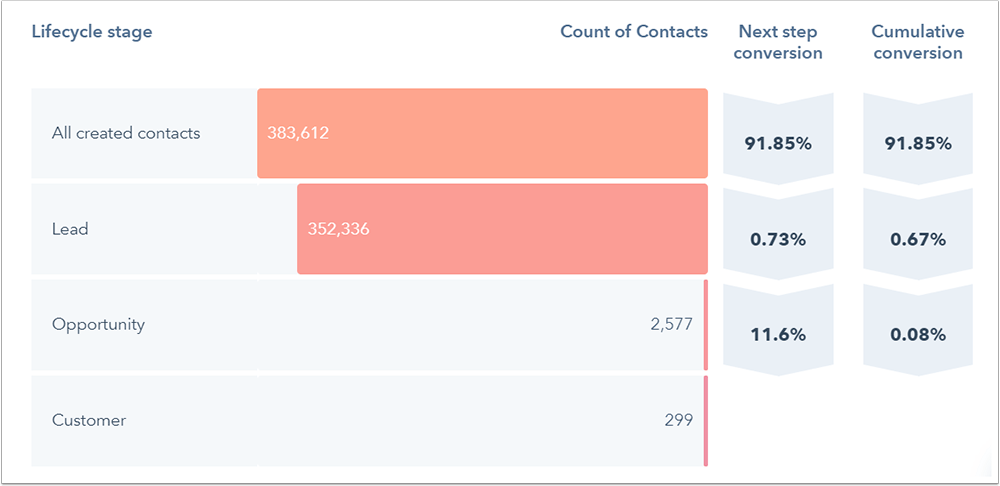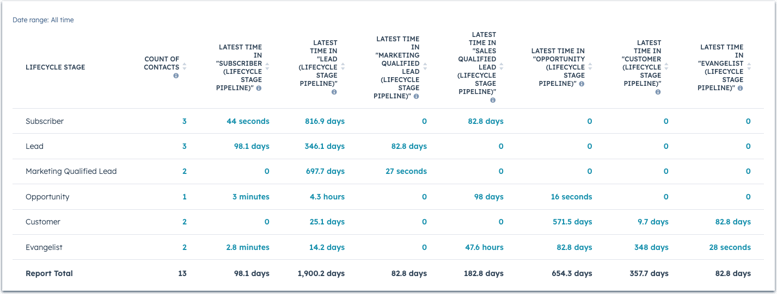The HubSpot Lifecycle Stages Guide

Some businesses seem to have a magic touch when it comes to turning leads into customers. If you are using HubSpot, a big part of that ‘magic’ is mastering HubSpot lifecycle stages.
Understanding the customer journey is pivotal for effective digital marketing and HubSpot’s Lifecycle Stages provide a robust framework for that. Businesses can utilize this to monitor and nurture leads from their first interaction to becoming loyal customers and even brand advocates.
Table of Contents
What are the standard lifecycle stages of HubSpot?

HubSpot lifecycle stages mark key milestones throughout your customers’ interaction with your business. This helps your sales and marketing teams with delivering the right message at the right time and; eventually, move your prospects down the funnel.
Here are the default HubSpot lifecycle stages that you get out of the box.
Subscriber
This stage includes individuals who have shown initial interest in your content by subscribing to your blog, newsletter, or other subscription forms. It’s the earliest stage of engagement. For marketing, focus on delivering consistent, valuable content to build trust and nurture these subscribers into leads.
Lead
Leads have interacted with your marketing content beyond just subscribing. They might have downloaded a whitepaper, an ebook, or attended a webinar. At this stage, you should segment your leads based on their interests and engagement and target them with more personalized content to encourage them to move further down the funnel.
Marketing Qualified Lead (MQL)
MQLs are leads considered more likely to become customers. They have engaged with your marketing efforts to a degree that suggests a strong potential for sales conversion. Use lead scoring to identify MQLs based on their activities, like downloading specific content, visiting pricing pages, or repeated site visits. Tailor your marketing to address their specific pain points and needs.
Sales Qualified Lead (SQL)
These are leads that your sales team has qualified as potential customers. They have passed the initial marketing qualification and are ready for direct sales engagement. At this point, sales and marketing should work closely together. Sales teams can provide feedback to marketing about lead quality, which can refine marketing strategies.
Opportunity
Opportunities are leads that are in active sales conversations. They are considered potential deals. Here, the focus is on sales activities – product demonstrations, detailed proposals, and negotiation. Marketing can support this stage by providing sales enablement materials like case studies, testimonials, and detailed product information.
Customer
This is when a lead has made a purchase and becomes a customer. The marketing focus shifts to customer retention and loyalty. Engage them with onboarding materials, training, and support to ensure a great customer experience. Also, consider upselling or cross-selling strategies where appropriate.
Evangelist
Evangelists are highly satisfied customers who advocate for your brand. They can be leveraged for testimonials, case studies, and referrals. Encourage them to share their experiences on social media, and consider implementing a referral program to reward their advocacy.
Other
This category is for contacts that don’t neatly fit into the other stages. It’s important to regularly review and categorize these contacts. They may include stakeholders, influencers, or other individuals who interact with your brand but don’t follow the traditional customer journey.
Each of these stages represents a different level of engagement with your brand and requires different marketing strategies. By understanding and effectively utilizing these stages, you can create more targeted and effective marketing campaigns that guide prospects through the buyer’s journey.

How Can You Use HubSpot Lifecycle Stages?
Understanding and utilizing HubSpot’s lifecycle stages can significantly enhance your marketing and sales strategies. Check the following uses of HubSpot’s lifecycle stages to see how they can be used to better engage with your contacts, align your marketing and sales efforts, and drive conversions.
Segmenting Contacts
HubSpot’s lifecycle stages allow for organizing contacts into distinct categories based on their interaction level. This segmentation can help you in creating focused marketing campaigns tailored to each group’s needs and interests.
Tailoring Communication
By understanding the lifecycle stage of a contact, you can send them relevant information. For example, sending educational content to leads and product-focused information to opportunities.
Sales and Marketing Alignment
These stages facilitate a clear transition of leads from marketing to sales. This helps in ensuring that only qualified leads are passed on to the sales team.
Measuring Performance
By analyzing the movement of contacts through different stages, you can measure the effectiveness of your marketing strategies and identify areas for improvement.
Lead Nurturing
Lifecycle stages assist in developing strategies to nurture leads at each stage. This involves providing appropriate content and interaction to guide them toward making a purchase.
How to Update the Lead Status Property in HubSpot
Now, let’s talk about ways to update HubSpot lifecycle stages for consistent data management. These methods help keep your contact information up-to-date and efficient for your marketing campaigns.
Manual Updates
In HubSpot, you can manually change a contact’s lifecycle stage by editing their contact record. This is useful for one-off updates or exceptions.
Using Workflows
Set up automated workflows in HubSpot that change a contact’s lifecycle stage based on specific triggers, like form submissions or email interactions. This automates the process for a large number of contacts.
Lead Scoring
Implement a lead scoring system that assigns points to contacts based on their interactions. When a contact reaches a certain score, its lifecycle stage is automatically updated.
Integrations
Utilize integrations with other tools (like CRM systems) that can sync with HubSpot to update lifecycle stages based on activities or milestones achieved in those systems.
Customizing HubSpot Lifecycle Stages
Default HubSpot lifecycle stages are designed to fit most marketing needs, but they may not perfectly align with yours. Customizing these stages allows you to tailor your marketing and sales strategies more effectively.
Before you change the default HubSpot lifecycle stages, you need to understand your sales process deeply and identify any stages that are unique to your business. Then, you can use HubSpot’s customization features to modify or add new stages. This might involve renaming existing stages or creating entirely new ones to better reflect your customer journey.
However, don’t forget to be strategic about these changes. Every alteration should have a clear purpose and benefit, such as aligning with your sales process or providing clearer segmentation for marketing campaigns. Also, consider the impact of these changes on your reporting and team’s workflow.
If you are new to HubSpot, it may be a good idea to get comfortable with the default stages first. Understand how they align with your business, and then proceed with customization if necessary. This ensures a solid foundation before diving into more advanced features of the platform. You can find more information on changing HubSpot lifecycle stages at HubSpot’s website.

The Impact of Accurate Lifecycle Stage Tracking on ROI
Here are the benefits of maintaining accurate lifecycle stage tracking.
1) Strategic Customer Journey Insight
- Understanding where customers are in their journey is key to maximizing returns.
- Lifecycle stages act as a roadmap for growth, enhancing sales and marketing alignment.
2) Effective Communication Targeting
- Tailor your approach based on the customer’s readiness to buy.
- Targeted communications lead to higher conversion rates as messages resonate more effectively.
3) Elevating Lead Quality Through Precision Targeting
- Precise tracking ensures each lead is correctly categorized from the start.
- This allows for high-potential leads to receive appropriate attention while nurturing others efficiently.
4) Sales Efficiency: Smarter Effort Distribution
- Knowing each prospect’s stage allows sales teams to prioritize effectively.
- This leads to shorter sales cycles and higher win rates, thus increasing ROI.
5) Fostering Customer Retention by Anticipating Needs
- Retention is crucial as it’s more cost-effective than acquiring new customers.
- Accurate post-purchase data helps in making more intuitive upselling or cross-selling offers.
Overall, leveraging HubSpot’s lifecycle stages can transform your marketing approach, leading to significant ROI improvements through tailored strategies, efficient sales processes, and enhanced customer retention efforts.
Best Practices for Managing Lifecycle Stages in HubSpot
Managing lifecycle stages in HubSpot effectively is a key component to streamlining your marketing and sales processes. Let’s dive into some best practices that will keep your team on track and your contacts engaged:
1) Know Your Audience
- It’s essential to understand who you’re engaging with at each stage. Tailoring your approach to whether someone is a lead, MQL, SQL, or customer ensures more meaningful interactions.
- For instance, a lead might need more educational content, while an SQL would benefit from more detailed product information.
2) Create Content that Resonates
- Crafting stage-appropriate content is key. A new visitor requires different information compared to someone on the cusp of purchasing.
- Utilize HubSpot’s segmentation and targeting tools to deliver this content effectively.
3) Setting Clear Criteria for Each Stage
- Define specific triggers for transitioning between stages. These could include email interactions, content downloads, or direct sales engagements.
- Consistently train your team on these criteria to maintain a uniform understanding and approach.
4) Leveraging Automated Workflows Effectively
- Use HubSpot’s automation to facilitate smooth transitions. For example, when a contact moves from ‘Lead’ to ‘MQL’, trigger a welcome sequence automatically.
- This timely and relevant communication keeps the contact engaged and moving through the sales funnel efficiently.
5) Cleaning Data Regularly for Accuracy
- Regular data hygiene is crucial. Keep your lists clean and ensure accurate lifecycle stage assignments using HubSpot’s data management tools.
- Accurate data leads to better targeting and, ultimately, a stronger personal connection with each contact.
6) Monitor and Adjust
- Continuously monitor the performance of your lifecycle stage strategies. Use HubSpot’s analytics to understand what’s working and where adjustments are needed.
- Don’t be afraid to tweak your criteria or content strategies based on performance data.
7) Train and Re-Train
- Regularly train new team members on your lifecycle management practices and refresh existing team members’ knowledge.
- This ensures everyone is up-to-date with the latest strategies and tools.
8) Encourage Team Feedback
- Get feedback from your team, especially those interacting directly with customers. They can provide insights into what’s working and what isn’t.
- This feedback loop can lead to more effective lifecycle stage management.
Remember, managing lifecycle stages is not a one-time setup but an ongoing process of refinement and improvement. Keep iterating and adapting your strategies to meet the evolving needs of your audience and business.
Conclusion
So you’ve journeyed through the ins and outs of HubSpot lifecycle stages. You’ve seen how they guide leads to become loyal customers. Remember, each stage is a step towards growth.
Keep in mind, personalizing your approach is key. Align marketing with sales; it’s not just helpful, it’s essential. Automate where you can but always keep it human.
Tracking progress boosts ROI. It turns maybes into definites by improving lead quality and sales efficiency.
Tie these stages into your CRM for seamless synergy between teams—because when they’re in sync, conversions climb.
Leverage real-world successes as your blueprint. Let them inspire strategies that resonate with contacts at every touchpoint.
Your takeaway? Mastering HubSpot lifecycle stages isn’t just useful—it’s vital for turning strangers into promoters and driving sustainable success.